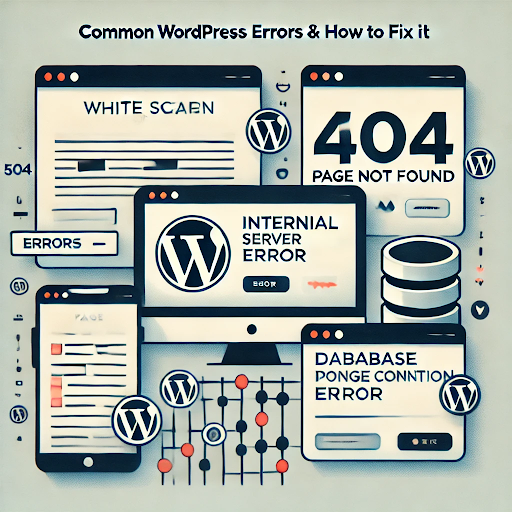Testing and Debugging in WordPress Development || Wordpress
Testing and Debugging in WordPress Development: A Comprehensive Guide
WordPress is one of the most popular content management systems (CMS) in the world, powering over 40% of all websites on the internet. With such widespread usage, ensuring that your WordPress site functions flawlessly is crucial. This is where testing and debugging come into play.
Whether you're a beginner or an experienced developer, encountering bugs and errors is inevitable. However, knowing how to efficiently test and debug your WordPress site can save you time, reduce frustration, and improve overall performance.
In this blog, we’ll explore:
✔ Why Testing & Debugging Matter in WordPress
✔ Types of Testing in WordPress Development
✔ Common WordPress Errors & How to Fix Them
✔ Best Tools for Debugging WordPress
✔ Best Practices for a Bug-Free WordPress Site
Let’s dive in!
Why Testing & Debugging Matter in WordPress
Before launching a WordPress site, thorough testing ensures that everything works as intended. Debugging helps identify and fix issues that may arise during development or after updates.
Key Reasons to Test & Debug:
Prevent Site Crashes – A single coding error can break your entire site.
Enhance User Experience – Bugs can slow down your site or cause functionality issues.
Security – Debugging helps identify vulnerabilities before hackers exploit them.
SEO Performance – Errors can affect search engine rankings.
Plugin & Theme Compatibility – Ensure new updates don’t conflict with existing setups.
Testing and debugging should be an ongoing process, not just a one-time task before launch.
Types of Testing in WordPress Development
Different testing methods help ensure your WordPress site runs smoothly. Here are the most important ones:
1. Unit Testing
Tests individual components (functions, classes, plugins) in isolation.
Ensures each part works correctly before integration.
Tools: PHP Unit, WP-CLI, Code ception
2. Integration Testing
Checks how different components (themes, plugins, core) work together.
Example: Testing if a contact form plugin works with your theme.
Tools: Behat, WP Browser
3. Functional Testing
Verifies if the site works as expected from a user’s perspective.
Example: Testing checkout flow in WooCommerce.
Tools: Selenium, Cypress, WP Test Suite
4. Performance Testing
Measures site speed, load time, and server response.
Identifies bottlenecks affecting performance.
Tools: GTmetrix, Pingdom, Lighthouse
5. Security Testing
Detects vulnerabilities like SQL injections, XSS attacks, and weak passwords.
Tools: Wordfence, Sucuri, WPScan
6. Cross-Browser & Device Testing
Ensures your site works on all browsers (Chrome, Firefox, Safari) and devices (mobile, tablet, desktop).
Tools: Browser Stack, Lambda Test
7. Usability Testing
Checks if the site is intuitive and easy to navigate.
Involves real users to gather feedback.
By implementing these testing methods, you can catch issues early and deliver a seamless experience.
Common WordPress Errors & How to Fix Them
Even well-built WordPress sites encounter errors. Here are some common ones and their fixes:
1. White Screen of Death (WSOD)
Cause: PHP error, memory limit, or plugin conflict.
Fix:
Enable WP_DEBUG in
wp-config.php.Increase memory limit:
define('WP_MEMORY_LIMIT', '256M');Disable plugins via FTP by renaming the plugins folder.
2. 500 Internal Server Error
Cause: Corrupt
.htaccess, PHP version mismatch, or server issues.Fix:
Rename
.htaccessto.htaccess_oldand regenerate it.Check PHP version compatibility (WordPress recommends PHP 8.0+).
Contact hosting support if the issue persists.
3. Database Connection Error
Cause: Incorrect database credentials or corrupted database.
Fix:
Verify
wp-config.phpdatabase details.Repair database via
define('WP_ALLOW_REPAIR', true);
4. 404 Not Found Errors
Cause: Permalink structure issues or broken links.
Fix:
Go to Settings > Permalinks and click "Save Changes."
Use Redirection Plugin to fix broken links.
5. Plugin/Theme Conflicts
Cause: Incompatible plugins or outdated themes.
Fix:
Deactivate plugins one by one to identify the culprit.
Switch to a default theme (e.g., Twenty Twenty-Four) to check for conflicts.
6. Slow Loading Speed
Cause: Unoptimized images, bloated plugins, or poor hosting.
Fix:
Use WP Rocket or Smush for optimization.
Enable caching and use a CDN (Cloudflare).
Upgrade to a better hosting provider (Kinsta, WP Engine).
Best Tools for Debugging WordPress
To make debugging easier, use these powerful tools:
1. WP_DEBUG
Enables WordPress debugging mode.
Add to
wp-config.php:define('WP_DEBUG', true); define('WP_DEBUG_LOG', true); define('WP_DEBUG_DISPLAY', false);
2. Query Monitor
A must-have plugin for debugging database queries, hooks, and PHP errors.
3. Debug Bar
Adds a debug menu to the admin bar with performance insights.
4. Chrome Dev Tools
Inspect frontend issues (JavaScript errors, CSS conflicts).
5. New Relic
Monitors server performance and detects bottlenecks.
6. Log Deprecated Notices
Helps find outdated functions in themes/plugins.
7. Blackfire.io
Performance profiling tool for PHP applications.
Using these tools will help you quickly identify and resolve issues.
Best Practices for a Bug-Free WordPress Site
Follow these tips to minimize errors:
✅ Always Use a Staging Site – Test updates before applying them live.
✅ Keep WordPress Core, Themes & Plugins Updated – Reduces security risks.
✅ Use Version Control (Git) – Track changes and revert if needed.
✅ Enable Regular Backups – Use Updraft Plus or host-provided backups.
✅ Optimize Database – Use WP-Optimize to clean up.
✅ Monitor Error Logs – Check wp-content/debug.log for issues.
✅ Follow Coding Standards – Adhere to WordPress PHP & JavaScript standards.
Final Thoughts
Testing and debugging are essential steps in WordPress development. Ignoring them can lead to broken sites, security risks, and poor user experiences. By using the right tools, following best practices, and staying proactive, you can maintain a high-performing, error-free WordPress site.
What’s your biggest challenge with WordPress debugging? Let me know in the comments!
Enjoyed this guide? Share it with fellow WordPress developers! 🚀
#WordPress #Debugging #WebDevelopment #Testing #WPDevelopment







Comments
Post a Comment